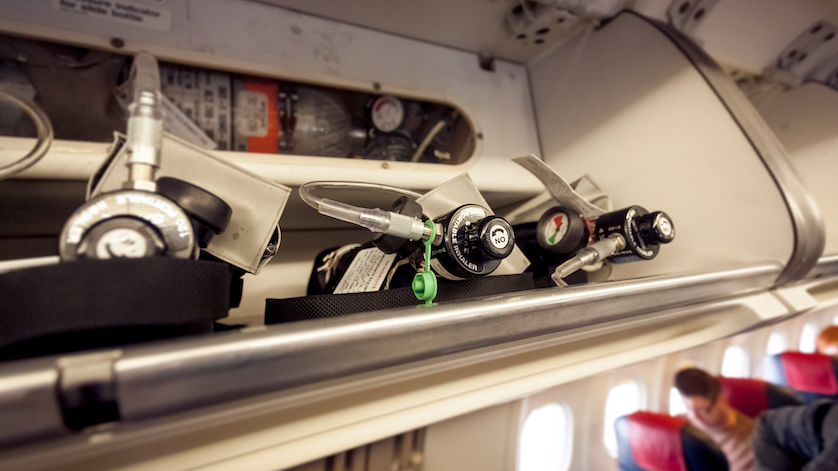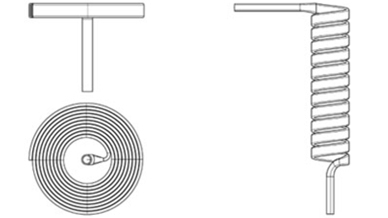
With only one moving part, direct drive pressure gauges are extremely compact, rugged, and reliable. These characteristics are what make them ideal for use in safety-critical applications, such as oxygen systems found in airplanes and submarines.
The traditional Bourdon tube gauge offers many advantages: good accuracy, low cost, adaptability for electrical outputs, and wide operating range – from vacuum to an upper limit of around 20,000 psi (1,600 bar). That’s why even though the technology dates from the mid-1800s, this type of mechanical pressure gauge is still found in a myriad of industrial applications today.
However, the traditional C-shaped Bourdon gauge has several moving parts: spring, segment and pinion gears, linkage, pivot, and lever. More parts mean greater potential for wear and gauge failure in applications with extreme vibration and pulsation. What’s more, all those components take up space. The smallest Bourdon tube gauge has a nominal size of 1½” (40 mm), often too large for applications like portable gas cylinders.
Out of these drawbacks came the direct drive gauge.
Measuring Principle of the Direct Drive Gauge

A direct drive gauge has either a spiral (left) or helical Bourdon tube made of the superalloy Inconel® X-750.
A direct drive gauge has a Bourdon tube, but it is in a spiral or a helical (corkscrew) formation instead of the traditional C shape. The coil, made of the corrosion-resistant superalloy Inconel® X-750, expands under pressurization. The pointer shaft, which is attached directly to the spiral or helical tube, moves right or left as the coiled tube expands or contracts. See this video for a detailed explanation of how a direct drive gauge works.
Spiral is by far the more popular pressure element, as it measures lower pressures and uses less of the superalloy. A higher maximum pressure and, thus, more material equal a higher cost for direct drive gauges with a helical Bourdon tube.
With just one moving part, direct drive gauges offer several important advantages:
- They are able to withstand extreme vibration, shock, and pulsation without requiring a liquid fill.
- They have the same accuracy throughout their long service life and do not require recalibration.
- If one breaks, it has a much lower escape velocity than a traditional Bourdon tube gauge.
- The entire mechanism can be flat and extremely compact: as small as ¾” (19 mm) in diameter.
These benefits are why direct drive gauges are ideal for measuring oxygen pressure in aerospace and military applications, especially when space is tight.
History and Excellence of WIKA Direct Drive Gauges
In the early 1970s, Kaiser Aerospace invented the direct drive gauge specifically for safety-critical applications. One of the companies that spun off from that original development was 3D Instruments (3D stands for Direct Drive Difference), which WIKA acquired in 2010.
We offer the option for these gauges to be oxygen-cleaned to ASME B40 Level IV, and can provide testing certificates for vibration amplitude (g rating). Our direct drive gauges are currently manufactured in Lawrenceville, Georgia. Additionally, our facility in Columbus, Ohio is certified to AS9100 for aerospace and ITAR certified for military compliance regarding export control.
Once manufactured, these gauges are not adjustable. In other words, the indication angle is always defined as 1:1 by the deflection of the pressure element end. That’s the reason they are so difficult to make. WIKA is one of the only companies in the world that can engineer direct drive gauges.
Aerospace- and Military-Grade Pressure Gauges
Today, our direct drive gauges and embedded direct drive units are found in a variety of aerospace and defense applications:
- Emergency oxygen systems and oxygen panels in smaller airplanes
- Oxygen bottles and oxygen tanks in larger aircrafts
- Oxygen systems for elite military teams’ personal submarines
- Military SCBA units for divers
- Other sub-sea applications
WIKA specializes in customization so clients can easily add our direct drive gauges to their own equipment. We are able to manufacture them in almost any size (from ¾” on up) and pressure range (typically 500 to 10,000 psi). The dial can be configured to be read from the front or the sides, and is customized with the client’s required pressure scale(s), colors, layout, logo and text, etc. We can also supply the “guts” – just the pressure element without any housing – so aerospace and military customers can incorporate them directly into their own products.
Every application has different requirements. The experts at WIKA USA work closely with customers to precisely engineer the direct drive gauge or pressure element they need for their specific oxygen system. Contact us for more details about aerospace- and military-grade pressure solutions.


I work in ISRO, the space agency for India. I’m interested in the direct drive pressure gauge supplied by you. I’m looking for an aerospace quality absolute pressure gauge of the range 0 – 1.6 bar (abs). This is to be resistant to vibration of high levels. Please let me know if you wish to take it up further.
Jithesh Sivadasan C M
Scientist/Engineer, Liquid Propulsion Systems Centre, ISRO, Valiamala
Hey Jithesh, Your inquiry has been passed along and you should be hearing from someone soon if you have not already.
I will. Like. Look. Open position. Hire job
Hi Benjamin, If you are interested in looking at our open positions feel free to click on the “Apply Now” button on this page.